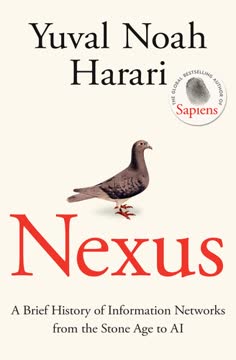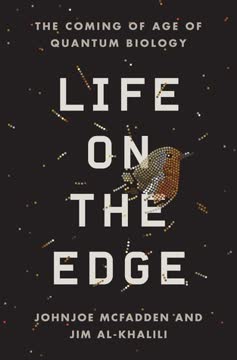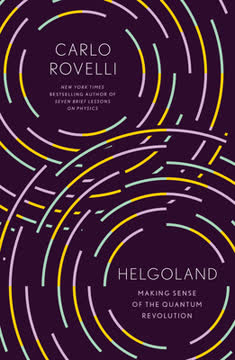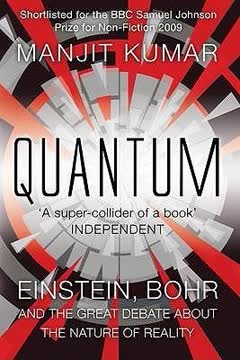نکات کلیدی
1. درهمتنیدگی: ارتباط عجیب کوانتومی
"درهمتنیدگی نه تنها یک ویژگی، بلکه ویژگی اصلی مکانیک کوانتومی است."
درهمتنیدگی کوانتومی پدیدهای است که در آن دو یا چند ذره به طور غیرقابلانفکاکی به هم مرتبط میشوند، بدون توجه به فاصلهای که بین آنها وجود دارد. این اثر عجیب امکان ارتباط آنی بین ذرات درهمتنیده را فراهم میکند، بهگونهای که به نظر میرسد محدودیت سرعت نور که توسط نظریه نسبیت اینشتین تعیین شده است را نقض میکند.
جنبههای کلیدی درهمتنیدگی:
- ذرات میتوانند در ویژگیهای مختلفی مانند اسپین یا قطبش درهمتنیده شوند
- اندازهگیری یک ذره بلافاصله بر شریک درهمتنیدهاش تأثیر میگذارد
- این اثر حتی زمانی که ذرات با فاصلههای زیادی از هم جدا شدهاند، پایدار میماند
- اینشتین بهطور معروف به این پدیده به عنوان "عمل عجیب از راه دور" اشاره کرد
درهمتنیدگی چالشهایی را برای درک بنیادی ما از واقعیت، علیت و ماهیت اطلاعات در جهان به وجود میآورد.
2. تولد نظریه کوانتوم: ثابت پلانک
"پلانک یک فکر جدید و پیشتر تصور نشده را مطرح کرد، فکر ساختار اتمی انرژی."
کشف ماکس پلانک از کوانتوم عمل در سال 1900، تولد نظریه کوانتوم را رقم زد. پلانک ایدهای را معرفی کرد که انرژی به صورت بستههای گسسته یا کوانتا منتشر و جذب میشود، نه به صورت پیوسته.
ثابت پلانک (h):
- ثابت بنیادی طبیعت
- انرژی فوتون را به فرکانس آن مرتبط میکند: E = hν
- توضیحدهنده فاجعه فرابنفش در تابش جسم سیاه
- منجر به توضیح اینشتین از اثر فوتوالکتریک شد
این مفهوم انقلابی پایهای برای توسعه مکانیک کوانتومی و درک ما از دنیای میکروسکوپی فراهم کرد.
3. دوگانگی موج-ذره: دوبروی و شرودینگر
"پس از تأمل طولانی در تنهایی و مدیتیشن، ناگهان در سال 1923 به این ایده رسیدم که کشف اینشتین در سال 1905 باید با گسترش به تمام ذرات مادی و بهویژه الکترونها تعمیم یابد."
فرضیه لویی دوبروی که ماده ویژگیهای موجی دارد، همراه با معادله موجی اروین شرودینگر، دوگانگی موج-ذره را به عنوان یک اصل بنیادی مکانیک کوانتومی تثبیت کرد.
توسعههای کلیدی:
- طول موج دوبروی: λ = h/p (که در آن p تکانه است)
- معادله موجی شرودینگر: توصیفکننده حالات کوانتومی و تکامل آنها
- تابع موج (ψ): نمایانگر حالت کوانتومی یک سیستم
- تفسیر بورن: |ψ|² چگالی احتمال یافتن یک ذره را میدهد
این مفاهیم درک ما از ماده و انرژی را متحول کردند و به فناوریهایی مانند میکروسکوپهای الکترونی و توضیح پدیدههایی مانند اوربیتالهای اتمی منجر شدند.
4. عدم قطعیت و مکملیت: هایزنبرگ و بور
"ما ابتدا خواهیم فهمید که جهان چقدر ساده است وقتی که درک کنیم چقدر عجیب است."
اصل عدم قطعیت هایزنبرگ و اصل مکملیت بور ایدههای اساسی در مکانیک کوانتومی هستند که مفاهیم کلاسیک اندازهگیری و واقعیت را به چالش میکشند.
اصل عدم قطعیت:
- Δx · Δp ≥ ħ/2 (که در آن ħ = h/2π)
- محدودیت دقت در اندازهگیری همزمان متغیرهای مزدوج
- اعمال به موقعیت-تکانه، انرژی-زمان و جفتهای دیگر
اصل مکملیت:
- جنبههای موج و ذره متقابلاً انحصاری اما مکمل هستند
- تنظیمات اندازهگیری تعیین میکند که کدام جنبه مشاهده میشود
- نمونهای از آن آزمایش دو شکاف است
این اصول طبیعت احتمالی مکانیک کوانتومی و نقش مشاهده در تعیین واقعیت را برجسته میکنند.
5. چالش اینشتین: پارادوکس EPR
"خدا با جهان تاس نمیاندازد."
نارضایتی اینشتین از طبیعت احتمالی مکانیک کوانتومی منجر به آزمایش فکری معروف EPR (اینشتین-پودولسکی-روزن) شد که به چالش کشیدن کامل بودن نظریه کوانتوم پرداخت.
استدلال EPR:
- پیشنهاد وجود "متغیرهای پنهان" برای توضیح همبستگیهای کوانتومی
- استدلال برای واقعگرایی محلی: رویدادها در یک مکان نباید بلافاصله بر مکانهای دور تأثیر بگذارند
- پیشنهاد کرد که مکانیک کوانتومی ناقص است
پارادوکس EPR بحثهای شدیدی درباره ماهیت واقعیت و پایههای مکانیک کوانتومی به وجود آورد و به توسعههای نظری و تجربی بیشتری منجر شد.
6. قضیه بل: اثبات عجایب کوانتومی
"قضیه بل عمیقترین کشف علم است."
قضیه انقلابی جان بل راهی برای آزمایش تجربی پیشبینیهای مکانیک کوانتومی در برابر نظریههای متغیرهای پنهان محلی فراهم کرد.
نابرابری بل:
- فرمولبندی ریاضی برای تمایز مکانیک کوانتومی از واقعگرایی محلی
- اگر نقض شود، از مکانیک کوانتومی و غیرمحلی بودن حمایت میکند
- اگر رعایت شود، از نظریههای متغیرهای پنهان محلی حمایت میکند
کار بل پارادوکس EPR را از یک بحث فلسفی به یک سوال علمی قابل آزمایش تبدیل کرد و زمینه را برای آزمایشهای مهم در فیزیک کوانتومی فراهم کرد.
7. تأیید تجربی: از اسپکت تا زایلینگر
"اینشتین گفت که اگر مکانیک کوانتومی درست باشد، جهان دیوانه خواهد بود. اینشتین درست میگفت—جهان دیوانه است."
مجموعهای از آزمایشهای انقلابی پیشبینیهای مکانیک کوانتومی و واقعیت درهمتنیدگی را تأیید کردند، که کار آلن اسپکت بهویژه مهم بود.
آزمایشهای کلیدی:
- کلاوزر و فریدمن (1972): اولین آزمایش نابرابری بل
- اسپکت و همکاران (1982): بستن شکاف محلی با سوئیچینگ سریع
- گروه زایلینگر: گسترش آزمایشها به فواصل بیشتر و با ذرات مختلف
- گیسین و همکاران (1998): نشان دادن درهمتنیدگی در 10 کیلومتر در فیبرهای نوری
این آزمایشها بهطور مداوم نابرابری بل را نقض کردند و شواهد قوی برای طبیعت غیرمحلی مکانیک کوانتومی و علیه نظریههای متغیرهای پنهان محلی ارائه دادند.
8. درهمتنیدگی سهگانه: GHZ و فراتر از آن
"عناصر واقعیت اینشتین وجود ندارند. هیچ توضیحی از رقص زیبای بین سه ذره نمیتوان در قالب یک جهان واقعاً واقعی ارائه داد."
حالت GHZ (گرینبرگر-هورن-زایلینگر) نمایانگر گسترش قدرتمند درهمتنیدگی به سه یا چند ذره است که رد قویتری از واقعگرایی محلی ارائه میدهد.
مزایای GHZ:
- اجازه میدهد قضیه بل بدون نابرابریها
- ارائه همبستگیهای کامل بین سه ذره
- نشان دادن غیرمحلی بودن کوانتومی بهطور مستقیمتر از درهمتنیدگی دو ذره
مطالعه درهمتنیدگی چندذرهای راههای جدیدی در نظریه اطلاعات کوانتومی و کاربردهای بالقوه در محاسبات کوانتومی باز کرده است.
9. تلهپورت کوانتومی: تبدیل علم تخیلی به واقعیت
"مکانیک کوانتومی عجیبترین اختراع بشر است، اما همچنین یکی از زیباترینها."
تلهپورت کوانتومی، انتقال یک حالت کوانتومی از یک مکان به مکان دیگر، کاربرد عملی درهمتنیدگی در پردازش اطلاعات کوانتومی را نشان میدهد.
فرآیند تلهپورت:
- استفاده از درهمتنیدگی به عنوان منبع
- نیاز به کانالهای ارتباطی کوانتومی و کلاسیک
- نابودی حالت کوانتومی اصلی در این فرآیند
- بهطور تجربی با فوتونها، اتمها و یونها به دست آمده است
اگرچه با تلهپورت علمی تخیلی یکسان نیست، این تکنیک پیامدهای مهمی برای محاسبات کوانتومی و ارتباطات امن دارد.
10. پیامدهای فلسفی: بازتعریف واقعیت و علیت
"نتیجهگیریهای قضیه بل از نظر فلسفی شگفتانگیز هستند؛ یا باید فلسفه واقعگرایانه اکثر دانشمندان را کاملاً رها کرد یا مفهوم فضا-زمان را بهطور چشمگیری بازنگری کرد."
تأیید درهمتنیدگی کوانتومی ما را مجبور میکند تا مفاهیم بنیادی در فیزیک و فلسفه را بازنگری کنیم.
چالشهای فلسفی:
- ماهیت واقعیت: آیا جهان ذاتاً احتمالی است؟
- محلی بودن: چگونه میتوان رویدادهای دور را بهطور آنی همبسته کرد؟
- علیت: آیا مکانیک کوانتومی اجازه علیت معکوس را میدهد؟
- اراده آزاد: چگونه عدمتعیینپذیری کوانتومی بر انتخاب انسانی تأثیر میگذارد؟
درهمتنیدگی دیدگاه عمیقتر و جامعتری از واقعیت را پیشنهاد میکند که در آن بخشهای جداگانه جهان بهطور بنیادی به روشهایی که شهود کلاسیک ما را به چالش میکشند، به هم متصل هستند.
آخرین بهروزرسانی::
FAQ
What’s Entanglement by Amir D. Aczel about?
- Exploration of quantum entanglement: The book investigates the phenomenon of quantum entanglement, where particles remain mysteriously linked across any distance, defying classical physics.
- Historical and scientific journey: It traces the development of quantum mechanics, highlighting key experiments and the contributions of major physicists like Einstein, Bohr, Schrödinger, and Bell.
- Philosophical and technological implications: The narrative delves into the philosophical challenges entanglement poses to our understanding of reality and locality, and connects these ideas to emerging technologies like quantum cryptography and teleportation.
Why should I read Entanglement by Amir D. Aczel?
- Accessible explanation of quantum concepts: The book breaks down complex quantum ideas, using clear language, diagrams, and repeated explanations to ensure understanding for readers without a physics background.
- Human side of science: It weaves in personal stories and anecdotes about the scientists behind the discoveries, making the history of quantum mechanics engaging and relatable.
- Connection to modern technology: Readers gain insight into how entanglement underpins cutting-edge technologies, linking abstract theory to real-world applications and future innovations.
What are the key takeaways from Entanglement by Amir D. Aczel?
- Entanglement is real and tested: Quantum entanglement is a genuine, experimentally confirmed phenomenon that challenges classical ideas of locality and realism.
- Bell’s theorem and GHZ states: These provide rigorous proofs of quantum nonlocality, showing that no local hidden-variable theory can explain quantum correlations.
- Foundation for quantum technology: Entanglement is not just a theoretical curiosity—it is the basis for quantum cryptography, teleportation, and other emerging technologies.
What are the best quotes from Entanglement by Amir D. Aczel and what do they mean?
- Abner Shimony: “The conclusions from Bell’s theorem are philosophically startling; either one must totally abandon the realistic philosophy of most working scientists or dramatically revise our concept of space-time.” This highlights the profound impact of Bell’s theorem on our worldview.
- David Mermin: “So farewell, elements of reality!” This quote underscores the departure from classical realism required by quantum mechanics.
- John Bell: “In view of the general success of quantum mechanics, it is very hard for me to doubt the outcome of such experiments. However, I would prefer these experiments... to have been done and the results on record.” Bell expresses the importance of experimental confirmation.
- Alain Aspect: “Bohr had an intuitive feeling that Einstein’s position, taken seriously, would conflict with quantum mechanics. But it was Bell’s theorem that materialized this contradiction.” Aspect credits Bell for making the philosophical debate testable.
How does Amir D. Aczel define quantum entanglement in Entanglement?
- Linked quantum states: Entanglement is when two or more particles become so deeply connected that the state of one instantly determines the state of the other, regardless of distance.
- Single system, not individuals: The book emphasizes that entangled particles are best understood as parts of a single quantum system, not as independent entities.
- Defies classical intuition: This phenomenon challenges classical ideas of locality and causality, leading Einstein to call it “spooky action at a distance.”
How does Entanglement by Amir D. Aczel explain the wave-particle duality and superposition principle?
- Wave-particle duality: The book recounts experiments like Young’s double-slit, showing that quantum entities (light, electrons, even molecules) exhibit both wave and particle characteristics.
- Superposition principle: Quantum systems can exist in multiple states simultaneously, such as a particle going through both slits at once, until measured.
- Measurement and collapse: The act of measurement causes the system to “collapse” into a definite state, a concept that challenges classical notions of reality.
What is Planck’s constant and its significance in quantum mechanics according to Entanglement by Amir D. Aczel?
- Quantum of action: Planck’s constant (h) is the fundamental unit that quantizes energy exchanges in quantum systems, marking the departure from classical continuity.
- Foundation for quantum theory: Its introduction solved the ultraviolet catastrophe and led to accurate models of black-body radiation.
- Central to atomic models: Planck’s constant underpins Bohr’s model of the atom, explaining discrete energy levels and spectral lines.
How does Amir D. Aczel describe the Copenhagen Interpretation in Entanglement?
- Probabilistic nature of quantum mechanics: The Copenhagen Interpretation, led by Niels Bohr, asserts that quantum systems exist in superpositions until measured, at which point they assume definite properties.
- Role of the observer: Measurement is fundamental; the observer’s act determines the outcome, challenging classical realism.
- Philosophical debates: This interpretation sparked intense debates, especially with Einstein, over the completeness and reality of quantum mechanics.
What is Heisenberg’s uncertainty principle and how is it presented in Entanglement by Amir D. Aczel?
- Limit on precision: The uncertainty principle states that certain pairs of properties, like position and momentum, cannot both be known exactly at the same time.
- Microscope analogy: The book uses Heisenberg’s thought experiment to illustrate how measuring one property disturbs the other.
- Probabilistic universe: This principle introduces inherent uncertainty into quantum mechanics, contrasting with the determinism of classical physics.
What is Bell’s theorem and why is it important in Entanglement by Amir D. Aczel?
- No local hidden variables: Bell’s theorem proves that no local hidden-variable theory can reproduce all quantum predictions, especially for entangled particles.
- Experimental testability: Bell derived inequalities that can be tested in the lab; violations of these inequalities confirm quantum mechanics and nonlocality.
- Philosophical impact: The theorem forces a choice between locality and realism, fundamentally altering our understanding of reality.
How does Amir D. Aczel explain the experiments testing entanglement in Entanglement?
- Clauser-Freedman experiment: This was the first definitive test of Bell’s inequalities, supporting quantum mechanics and ruling out local hidden variables.
- Aspect’s experiments: By dynamically switching measurement settings, Aspect’s work closed loopholes and provided strong evidence for nonlocality.
- Long-distance tests: Experiments like Gisin’s ten-kilometer fiber optic test demonstrated entanglement over large distances, confirming “spooky action at a distance.”
What is the GHZ state and its significance in Entanglement by Amir D. Aczel?
- Definition of GHZ state: GHZ (Greenberger-Horne-Zeilinger) states involve three or more particles entangled in a way that allows a more direct demonstration of quantum nonlocality.
- Stronger proof than Bell’s theorem: GHZ states provide a simpler and more powerful argument against local realism, showing perfect correlations that cannot be explained classically.
- Experimental realization: The book describes how GHZ states have been produced in laboratories, confirming theoretical predictions and connecting to topological ideas like Borromean rings.
نقد و بررسی
کتاب درهمتنیدگی نقدهای متفاوتی دریافت کرده است، با تحسین برای توضیح قابل فهم مفاهیم فیزیک کوانتومی و زمینه تاریخی آن. خوانندگان از سبک نوشتاری روشن و رویکرد روایی جذاب آن قدردانی میکنند. با این حال، برخی از جزئیات بیوگرافی بیش از حد و محتوای تکراری انتقاد میکنند. کتاب به خاطر پوشش آزمایشهای درهمتنیدگی و توسعههای نظری مورد تحسین قرار میگیرد، اگرچه برخی توضیحات را فاقد عمق میدانند. به طور کلی، این کتاب به عنوان مقدمهای خوب برای موضوع برای خوانندگان عمومی در نظر گرفته میشود، هرچند با مشکلات گاهبهگاه در سرعت روایت و سادهسازیهای بیش از حد.
Similar Books













